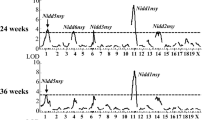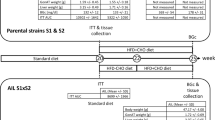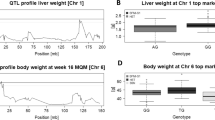Abstract
KK and KK-Ay mice serve as animal models of non-insulin-dependent diabetes mellitus with moderate obesity. Quantitative trait locus (QTL) analysis was performed to identify gene loci that account for fasting hyperglycemia, glucose intolerance and plasma insulin in 91 F2 females of a C57BL/6J×KK-Ay intercross. For glucose intolerance, a significant QTL was identified on chromosome 8, with a maximum lod score of 5.6. This locus had strong influence on the late phase of the intraperitoneal glucose tolerance test (IPGTT), suggesting that the locus may have role in glucose clearance rather than in mere hyperglycemia. In addition, three suggestive QTLs were identified on chromosomes 1 (fasting glucose), 3 (fasting insulin) and 4, (blood glucose at 120 min during IPGTT, and glucose intolerance).
This is a preview of subscription content, access via your institution
Access options
Subscribe to this journal
Receive 12 print issues and online access
$259.00 per year
only $21.58 per issue
Buy this article
- Purchase on Springer Link
- Instant access to full article PDF
Prices may be subject to local taxes which are calculated during checkout


Similar content being viewed by others
References
Nakamura M . A diabetic strain of the mouse Proc Jpn Acad 1962 38: 348–352.
Nakamura M, Yamada K . Studies on a diabetic (KK) strain of the mouse Diabetologia 1967 3: 212–221.
Nishimura M . Breeding of mice strains for diabetes mellitus Exp Anim 1969 18: 147–157.
Suto J, Matsuura S, Imamura K, Yamanaka H, Sekikawa K . Genetic analysis of non-insulin-dependent diabetes mellitus in KK and KK-Ay mice Eur J Endocrinol 1998 139: 654–661.
Suto J, Matsuura S, Imamura K, Yamanaka H, Sekikawa K . Genetics of obesity in KK mouse and effects of Ay allele on quantitative regulation Mamm Genome 1998 9: 506–510.
Suto J, Matsuura S, Yamanaka H, Sekikawa K . Quantitative trait loci that regulate plasma lipid concentrations in hereditary obese KK and KK-Ay mice Biochim Biophys Acta 1999 1453: 385–395.
Lander E, Kruglyak L . Genetic dissection of complex traits: guidelines for interpreting and reporting linkage results Nature Genet 1995 11: 241–247.
Genome Center Software. The Whitehead Institute for Biomedical Research/MIT Center for Genome Researchwww.genome.wi.mit.edu/
Mouse Genome Informatics;www.informatics.jax.org(accessed to July 2001)
Igel M, Taylor BA, Phillips SJ, Becker W, Herberg L, Joost HG . Hyperleptinemia and leptin receptor variant Asp600Asn in the obese, hyperinsulinemic KK mouse strain J Mol Endocrinol 1998 21: 337–345.
Shike T, Hirose S, Kobayashi M, Funabiki K, Shirai T, Tomino Y . Susceptibility and negative epistatic loci contributing to type 2 diabetes and related phenotypes in a KK/Ta mouse model Diabetes 2001 50: 1943–1948.
Author information
Authors and Affiliations
Corresponding author
Rights and permissions
About this article
Cite this article
Suto, J., Sekikawa, K. A quantitative trait locus that accounts for glucose intolerance maps to chromosome 8 in hereditary obese KK-Ay mice. Int J Obes 26, 1517–1519 (2002). https://doi.org/10.1038/sj.ijo.0802152
Received:
Revised:
Accepted:
Published:
Issue Date:
DOI: https://doi.org/10.1038/sj.ijo.0802152
Keywords
This article is cited by
-
Genetics of murine type 2 diabetes and comorbidities
Mammalian Genome (2022)
-
A novel mechanism regulating insulin secretion involving Herpud1 in mice
Diabetologia (2013)
-
A genetic and physiological study of impaired glucose homeostasis control in C57BL/6J mice
Diabetologia (2005)



